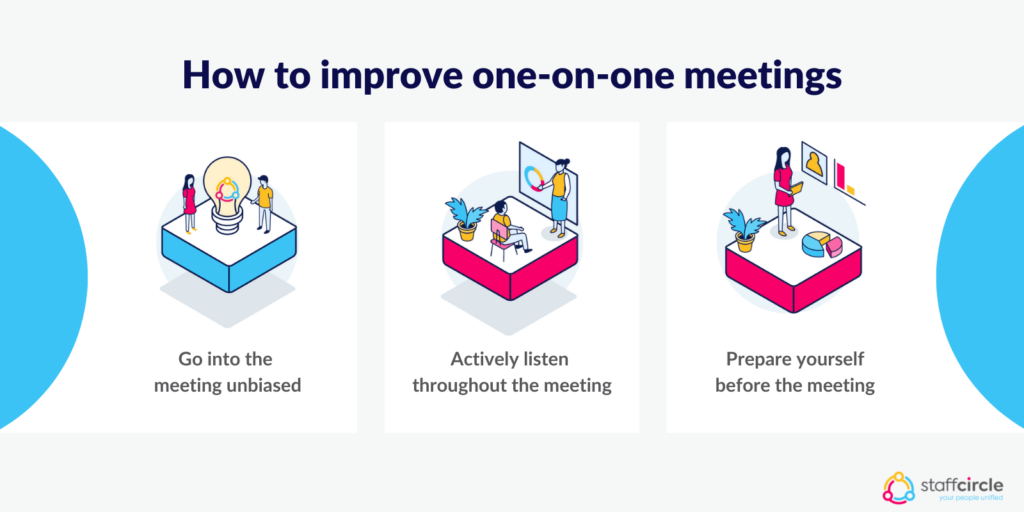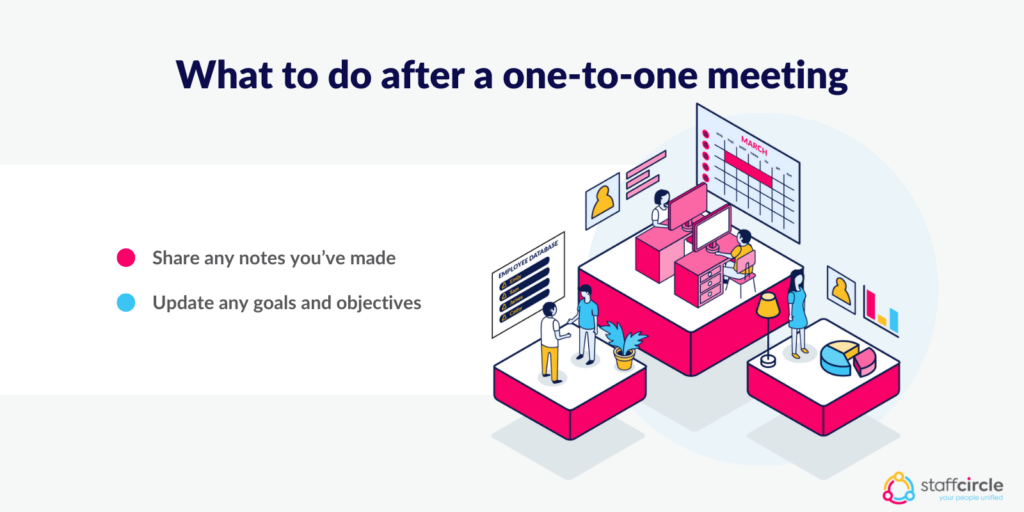One to ones are a great way for managers to meet up regularly with their direct reports to check in on career development and monitor job satisfaction. By using performance management tools, these sessions can be easily scheduled and conducted with regularity.
This complete guide to one-on-one meetings explores everything you need to know to get this important process right, from adopting the right mindset to following the correct steps for implementation.
What is the purpose of one-on-one meetings?
Effective performance management requires regular and consistent one-to-one check-ins to keep managers and team leaders connected with their employees. These meetings help to ensure that employees:
- Have a space for regular conversations about their current goals and objectives
- Can build and strengthen relationships with their managers
- Are able to raise issues relating to physical and mental health and well-being
- Develop coherent plans of action to further progress within the company
- Can give and receive honest feedback about their work
- Address any issues or problems before they become overwhelming
Let’s take a look at the purpose of one to ones in more detail.
Build a better work relationship with your employees
Healthy relationships between managers and employees don’t happen in a vacuum. In order to accomplish this, managers and team leaders need to engage their employees frequently with regular meetings.
One-to-one meetings are the bedrock for the development of these relationships, where employees and managers can discuss everything from the latest project to where they see their careers heading.
They are also crucial for identifying personal issues that may be affecting performance, particularly when the employee is working remotely. In these circumstances, it’s easy for managers to overlook problems they can’t see, so setting up online one-to-one sessions is essential for keeping in regular contact with remote employees.
Discuss issues and figure out how to diagnose the problem
One of the major issues with infrequent employee reviews is how easy it can be to overlook issues, allowing problems to compound and become overwhelming to address.
Regular one-on-one check-ins allow managers and employees to keep on top of any problems as and when they arise, so they can be dealt with in the short term. By linking these one-to-one meetings with the employee’s current objectives and key results, managers can ensure each meeting deals with any urgent matters.
Acknowledge their great work
Problem-solving is one aspect of one-on-one meetings, but managers should also take these meetings as opportunities to offer praise for great work. Recognition is a core driver of high performance, giving employees the confidence to continue working to the best of their abilities.
This acknowledgement can work well alongside a structured employee rewards plan, with some performance management tools enhancing this process further with peer-to-peer rewards. Rewards schemes aside, it’s hard to underestimate how far a simple “well done!” delivered face-to-face can go, and managers who take the time to do this will be rewarded with higher-performing staff.
How do one to ones work?
One-to-one meetings are very easy to set up and coordinate, particularly when using performance management tools to plan and schedule. You can use these tools to block regular time and prepare and share discussion points to make sure the conversations stay on the right track.

The article from Harvard Business Review outlines a number of ways you can make these one-to-one meetings more productive, including:
- Starting the meeting on a positive note
- Orienting the meeting towards problem-solving
- Asking employees questions about their career plans
- Expressing thanks for their good work
- Making the effort to listen and learn
Some other things to consider when arranging one-on-one meetings include:
Keep the meeting to around 30 minutes
Since these check-ins are carried out on a regular basis, there’s no need for them to take hours to conduct. Try keeping the meetings to around the thirty minutes mark so you can really focus on the core issues without getting distracted.
Making the meeting with individuals rather than a group meeting
One-to-one meetings should be exactly that; a focused conversation between an employee and their manager or direct report. These sessions can sometimes become personal, particularly if poor performance discussions are on the agenda, so make sure they are conducted with individuals to respect any sensitive issues being raised.
It is for everyone on the team
While one-to-one meetings should be carried out on an individual basis, all team members should have access to them. Everyone has their own personal and professional goals that need guidance from management, just as everyone has their own personal issues they need help to overcome.
Use your better judgment as to how often each team member might need these one-to-one check-ins, but make sure everyone is met on a regular basis. One of the purposes of these meetings is to flag issues that may otherwise get overlooked, so don’t assume a member of staff doesn’t have any problems until you’ve spoken to them directly.
Regularly schedule the meetings
One-on-one meetings are only effective when they are conducted on a regular basis. A recurring meeting should be conducted on a monthly, weekly or fortnightly basis depending on the requirements of the employee in question. A good time for weekly meetings is when checking in on a new hire, or an employee who is struggling. Use the opportunity to discuss the performance of the past week and lay out clear goals for the week ahead.
As well as being able to use performance management software to plan and schedule these sessions, you can use the software to send out reminder notifications when each meeting draws close. This is especially handy for managers handling sessions with off-site workers who they don’t see in person regularly.
Ask questions and take notes
One-on-one meetings aren’t just an opportunity for managers to offer constructive feedback on performance to employees; they’re a chance for employees to share updates and raise concerns.
Managers and team leaders responsible for these check-ins should approach them with open ears, taking the time to make notes and ask questions. This can be related to work objectives, well-being, or anything else deemed to be relevant and timely.
How can you improve your one-on-one meetings?
There are several approaches to one-on-one meetings that can elevate them from good to great, driving development and training and digging into an employee’s strengths and weaknesses to help transform them into A-players.

Feedback should be a core element of all these sessions, and there are several factors to consider to ensure this feedback is as effective as possible. The report from Deloitte, Principles For Delivering Effective Feedback, outlines the following:
“When giving feedback, congruence between what you say and how you say it is of utmost importance, because nonverbal signals will most likely be the default information that is processed. Understanding how to read and react to micro expressions can help you build trust and rapport.”
Managers should be mindful of how their body language improves how feedback is received, using nonverbal communication as well as their words to make sure the message is received and understood.
Go into the meeting unbiased
It can be easy for managers to enter one-to-one meetings with preconceived notions about what is affecting an employee’s performance. But there are a lot of factors outside their scope of awareness that could be playing a role, so going into the meeting unbiased is essential for getting to the heart of the matter.
Actively listen throughout the meeting
The best way to avoid letting personal biases influence a one-on-one meeting is to actively listen throughout the meeting. If necessary, take notes throughout the meeting so you have evidence to fall back on when following up on any action points in the future.
Prepare yourself before the meeting
As with any type of meeting, preparation is the key to making sure they run smoothly and address everything that needs to be discussed. Before conducting a one-on-one meeting with staff, managers should take the time to review any real-time performance feedback they have at hand, as well as the personal development goals the employee is currently working towards, and also set a clear meeting agenda to run through.
What to do within your one on one meetings
Before the meeting
Prior to each one-on-one meeting, managers and team leaders should do their homework to keep the meeting on track.

This means:
- Setting the context for the meeting. If the employee has an important deadline on the horizon, make sure you’re aware of where they currently are in their work and any help they might need to get things done. If it’s a quieter period of time at work, use this lull as a chance to dig into their career development plans.
- Creating a collaborative agenda. Giving the employee a heads up on what the meeting will cover allows them to prepare themselves for the conversation. If you’re planning on discussing a serious performance-related issue, let them know the details so they can come with a response ready.
- Defining a plan of action. One-to-one meetings are as much about planning for the future as they are about reflecting on the past. If you’re going to be discussing poor performance, have a cogent plan of action ready to help show them a path to success.
During the meeting
Once the meeting has begun, consider the following components to make the most of the discussion.
- Start with a personal touch. Health and well-being should be a consideration in every one-on-one meeting, even if this is a simple “how are things going with you?” at the start of the meeting. Some employees keep personal issues that are affecting their performance hidden, so checking in on a personal level gives them a chance to open up.

- Discuss any progress… Addressing their recent work and any successes they’ve had forms the core of a one-to-one session. Run through their recent goals and objectives and share any praise for work they’ve done well.
- …and any challenges. If the employee’s performance has fallen short of expectations, make sure this is addressed along with any insights from your personal observation. Be sure to ask them for their input as well, since managers can sometimes fail to pick up on issues affecting performance.
- Create an action plan. Once recent performance issues have been addressed, it’s time to talk through a plan of action to tide them over until the next one-to-one meeting. These goals can be updated in performance management software as objectives and key results, so everyone involved can track them in real-time.
After the meeting
Once the meeting has wrapped up there are a few steps you can take.
- Share any notes you’ve made with the employee. Coming up with ideas for improvement and development is all well and good, but if they aren’t shared with the employee they won’t be able to act upon them.
- Update any goals and objectives. If you’re using performance management tools to track goals, and the meeting brings up a new direction the employee needs to take, make sure their goals reflect these changes.

Summary
There has been an increasing shift towards frequent conversations between employees and their direct reports over the years. The most successful companies have long since moved from annual to monthly and quarterly reviews, and regular one-on-one meetings reflect this trend toward regular discussions.
This guide will help you to make the most of your one-on-one sessions, allowing managers to focus on career development, job satisfaction, and performance through ongoing conversations.





